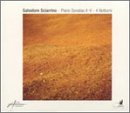| All Artists: Sciarrino, Hodges, Pizzo, Wosner Title: Piano Sonatas 2-5 / 4 Nocturnes Members Wishing: 0 Total Copies: 0 Label: Cypres Release Date: 3/26/2002 Album Type: Live Genre: Classical Styles: Chamber Music, Forms & Genres, Sonatas, Historical Periods, Classical (c.1770-1830), Modern, 20th, & 21st Century Number of Discs: 1 SwapaCD Credits: 1 UPC: 675754490126 |
Search - Sciarrino, Hodges, Pizzo :: Piano Sonatas 2-5 / 4 Nocturnes
 | Sciarrino, Hodges, Pizzo Piano Sonatas 2-5 / 4 Nocturnes Genre: Classical
|
Larger Image |
CD Details |
CD ReviewsLacunae, fragments, shards of piano-theatre scarecrow | Chicago, Illinois United States | 01/10/2005 (5 out of 5 stars) "If you love the timbre of the piano, you will not be disappointed in Sciarrino's piano music. We have two pianists here to mount this fascinating oeuvre. Sciarrino's creativity has a one-dimensional cast to it, like he prefers certain extroverted dazzling gestures, textures, and timbres, and they never leave him, like materials found in one's garden embedded in the earth that simply remain there for one's existence. This is the first recordings of the various/nefarious "Notturni", a relavant emotive icon within the Sciarrino aesthetic, the places of the night, searching for excitment or mystery, or anxiety, or pain,suffering. As in "Notturni I", there are lots of spaces "vuota" to not fill so much as "prepare" the next timbral event, this one is quite playful; The Italianate affinity for threadbare emotions(in Sciarrino's case reiterations of identical materials) that since all is not right in the world, you need to pull back from the dimensions of gravitas. Serious music had ended long ago anyway, the bougeosie killed contemporary music at least in the USA."NotturniII" has then more silences, (Nono called these "new silences") now with sparkled, dazzling single tones, to electrify the night, the penumbral, the dark spaces. The Sonatas ,there are Five were written over SCiarrino's life the Eighties and Nineties, and these (to me anyways) are like music in search of a dramatic situation,a search in the Bois du Boulonge, some invention for the theatre, or some performative art spectacle, his music doesn't quite have the power to stand alone, since he works at the realms of emotive extremities, as in "Sonata # IV" where we have an "abbatoir" like pummuling of the piano incessant attacks high and low, timbre is simply raped crazily, and you may never be the same afterwards. Likewise "Sonata III" is rather pointillistic,(the late Morton Feldman called this music (not SCiarrino's) but the materials,) a "clique" utilizations, and told his students to avoid this pointillistic stuff, for you need to move on to other places. So timbre is ripped to shreds here, and it makes for nice compelling virtuosic displays,the agenda for the Sonata is suppose to be timbre unadulterated, uninterrupted in tis quest to reach the "spirit", the "spectres" of whatever it amy or may not suggest. I wonder what Vladimir Horowitz would have thought of this music? It is remains incredibly interesting,if you accept Sciarrino's one-dimensionality. Even his theatre music has fascinating agendas, as his "Lohengrin" for electronics and one female voice", or "Perseus et Andromeda". These ancient rites seem to compell something primordial in Sciarrino like this piano music, It seems like it is material for some ancient passage, It is modern, but modern with lots of contingencies and reservations, like a land occupied. Both pianists here are excellent, Hodges has an incredible repertoire, and had worked closely with Sciarrino in performances of this music in Europe. You may prefer Massimiliano Damierini's to Hodges, in that bespectacled Damierini seems more extroverted and possossed, if that is at all possible in this music. You must be disciplined as well to project this music, it simply cannot be an invitation to violent anarchistic combustible display.
We haven't seen anymore piano works, so this is perhaps the ends of the fruitfull lands" |

 Track Listings (8) - Disc #1
Track Listings (8) - Disc #1